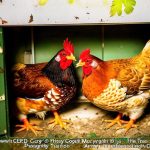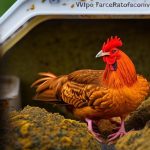Keeping sheep and chickens together is a widespread practice in small-scale and backyard farming operations, known as mixed or integrated farming. This approach involves raising multiple livestock species together to optimize resource and land utilization. Sheep and chickens are frequently combined due to their complementary characteristics in feeding habits, pest control, and waste management.
This integration allows farmers to create a more sustainable and efficient agricultural system that benefits both the animals and the environment. Mixed farming with sheep and chickens can lead to improved land productivity, reduced feed costs, and enhanced pest control, while also providing diversified income sources for farmers.
Table of Contents
- 1 Benefits of keeping sheep and chickens together
- 2 Considerations for keeping sheep and chickens together
- 3 Housing and space requirements for sheep and chickens
- 4 Feeding and nutritional needs for sheep and chickens
- 5 Health and disease management for sheep and chickens
- 6 Conclusion and final considerations for keeping sheep and chickens together
- 7 FAQs
- 7.1 Can you keep sheep and chickens together?
- 7.2 What are the benefits of keeping sheep and chickens together?
- 7.3 Are there any potential drawbacks to keeping sheep and chickens together?
- 7.4 What should be considered when keeping sheep and chickens together?
- 7.5 Are there any specific guidelines for keeping sheep and chickens together?
Key Takeaways
- Keeping sheep and chickens together can be a beneficial and sustainable practice for small-scale farmers and homesteaders.
- Benefits of keeping sheep and chickens together include natural pest control, efficient use of land, and complementary nutritional needs.
- Considerations for keeping sheep and chickens together include potential conflicts over food and space, as well as the risk of disease transmission.
- Housing and space requirements for sheep and chickens should prioritize separate sleeping and feeding areas, as well as adequate space for exercise and grazing.
- Feeding and nutritional needs for sheep and chickens should be carefully balanced to ensure both species receive the necessary nutrients for optimal health and productivity.
- Health and disease management for sheep and chickens should involve regular monitoring, vaccination, and biosecurity measures to prevent the spread of diseases between the two species.
- In conclusion, keeping sheep and chickens together can be a rewarding and sustainable practice, but it requires careful planning, management, and attention to the specific needs of each species.
Benefits of keeping sheep and chickens together
Efficient Use of Resources
One of the main benefits of keeping sheep and chickens together is the efficient use of resources. Sheep are grazers and primarily feed on grass and other vegetation, while chickens are omnivores and eat a variety of foods, including insects, seeds, and kitchen scraps. By allowing sheep to graze in the same pasture as chickens, farmers can ensure that the grass is kept at an optimal length for both types of animals, and the chickens can help control the insect population, reducing the need for chemical pest control.
Environmental Benefits
The waste produced by the sheep can be used to fertilize the pasture, which benefits the chickens by providing them with a healthier environment to forage for food.
Increased Income and Sustainability
Another benefit of keeping sheep and chickens together is the potential for increased income. By diversifying their farming operation, farmers can sell a wider range of products, including wool, meat, eggs, and even chicken manure. This can help farmers mitigate the risks associated with relying on a single source of income and provide them with more financial stability. Additionally, by keeping sheep and chickens together, farmers can reduce their reliance on external inputs such as chemical fertilizers and pesticides, which can lead to cost savings and a more sustainable farming operation.
Considerations for keeping sheep and chickens together

While there are many benefits to keeping sheep and chickens together, there are also several considerations that farmers should take into account. One important consideration is the potential for disease transmission between the two types of animals. Sheep and chickens can carry different types of diseases, and if they are kept in close proximity to each other, there is a risk that these diseases could spread.
To mitigate this risk, farmers should ensure that their animals are vaccinated and regularly monitored for signs of illness. Additionally, farmers should practice good biosecurity measures, such as keeping feed and water sources separate for the two types of animals and preventing direct contact between them. Another consideration for keeping sheep and chickens together is the potential for competition for resources.
Both types of animals require access to food, water, and shelter, and if these resources are limited, there is a risk that one type of animal could outcompete the other. To prevent this, farmers should ensure that there is enough space and resources available for both types of animals to thrive. This may involve rotating pastures or providing separate feeding areas to ensure that each type of animal has access to the resources they need.
Housing and space requirements for sheep and chickens
When keeping sheep and chickens together, it is important to provide adequate housing and space for both types of animals. Sheep require shelter from the elements, especially during extreme weather conditions, so farmers should provide them with a well-ventilated barn or shelter that protects them from wind, rain, and snow. Additionally, sheep need access to clean water and a comfortable resting area, so farmers should ensure that their housing facilities meet these requirements.
Chickens also require appropriate housing to protect them from predators and provide them with a safe environment to lay eggs. Chicken coops should be well-ventilated, predator-proof, and provide enough space for the chickens to move around comfortably. Additionally, farmers should provide nesting boxes for the hens to lay eggs and roosting bars for them to perch on at night.
In terms of space requirements, both sheep and chickens need access to outdoor areas for grazing and foraging. Farmers should ensure that their pastures are large enough to accommodate both types of animals and provide them with enough space to move around freely. Additionally, farmers should consider rotating pastures to prevent overgrazing and allow the land to recover.
Feeding and nutritional needs for sheep and chickens
When keeping sheep and chickens together, it is important to provide them with a balanced diet that meets their nutritional needs. Sheep are primarily grazers and require access to high-quality pasture or hay to meet their dietary requirements. Additionally, farmers may need to supplement their sheep’s diet with mineral blocks or feed during periods of low pasture availability or during times of increased nutritional demand, such as during pregnancy or lactation.
Chickens also require a balanced diet that includes a mix of grains, protein sources, fruits, vegetables, and grit for digestion. Farmers should provide their chickens with access to a commercial feed that is specifically formulated for their nutritional needs, as well as opportunities for free-ranging and foraging for insects and vegetation. When feeding sheep and chickens together, farmers should be mindful of potential competition for food resources.
To prevent this, farmers can provide separate feeding areas for each type of animal or stagger feeding times to ensure that both types of animals have access to the food they need.
Health and disease management for sheep and chickens

Vaccination and Parasite Control for Sheep
Sheep should be vaccinated against common diseases such as clostridial diseases (e.g., tetanus), foot rot, and internal parasites. Regular monitoring for signs of illness or injury is also vital, and prompt veterinary care should be provided when needed.
Vaccination and Parasite Control for Chickens
Chickens require regular vaccinations against common diseases such as Newcastle disease, infectious bronchitis, and fowl pox. A parasite control program should also be implemented to prevent infestations of mites, lice, and worms in the chicken flock. Regular monitoring for signs of illness or injury is essential, and appropriate care should be provided when needed.
Biosecurity Measures to Prevent Disease Transmission
To prevent disease transmission between sheep and chickens, farmers should practice good biosecurity measures. This includes keeping feed and water sources separate for the two types of animals, preventing direct contact between them, and regularly cleaning and disinfecting housing facilities.
Conclusion and final considerations for keeping sheep and chickens together
In conclusion, keeping sheep and chickens together can be a beneficial practice for small-scale and backyard farming operations. By integrating these two types of livestock, farmers can maximize the use of resources, increase income potential, and create a more sustainable farming system. However, there are several considerations that farmers should take into account when keeping sheep and chickens together, including disease management, resource competition, housing requirements, and nutritional needs.
To successfully keep sheep and chickens together, farmers should ensure that their animals have access to appropriate housing facilities that meet their specific needs. Additionally, farmers should provide a balanced diet that meets the nutritional requirements of both types of animals while preventing competition for food resources. Finally, maintaining the health of both sheep and chickens is essential to prevent disease transmission and ensure the well-being of the animals.
Overall, keeping sheep and chickens together can be a rewarding practice that benefits both the animals and the environment when done thoughtfully and responsibly. By considering the needs of both types of animals and implementing good management practices, farmers can create a harmonious farming system that maximizes productivity while promoting animal welfare and sustainability.
If you’re considering keeping sheep and chickens together, you may also be interested in learning about how many chickens you need for a family of 4. This article from Poultry Wizard provides valuable information on the ideal number of chickens to keep for a family of four, helping you plan and manage your poultry effectively. Learn more here.
FAQs
Can you keep sheep and chickens together?
Yes, it is possible to keep sheep and chickens together in the same area.
What are the benefits of keeping sheep and chickens together?
Keeping sheep and chickens together can provide mutual benefits such as pest control, as chickens can help control insects and parasites that may affect the sheep. Additionally, the two species can help keep each other company and provide a more diverse and integrated farm environment.
Are there any potential drawbacks to keeping sheep and chickens together?
One potential drawback is that chickens may peck at the sheep, especially if they are confined in a small space. Additionally, sheep may inadvertently trample on chicken eggs or chicks if they are not properly managed.
What should be considered when keeping sheep and chickens together?
It is important to provide adequate space and shelter for both the sheep and chickens. Additionally, proper management and monitoring of the animals is necessary to ensure their well-being and safety. It is also important to consider the specific needs and behaviors of each species when planning to keep them together.
Are there any specific guidelines for keeping sheep and chickens together?
It is recommended to provide separate feeding and watering areas for the sheep and chickens to prevent competition and potential conflicts. Additionally, regular monitoring and observation of the animals’ behavior is important to ensure their welfare. Consulting with a veterinarian or experienced farmers can also provide valuable insights and guidance.
Meet Walter, the feathered-friend fanatic of Florida! Nestled in the sunshine state, Walter struts through life with his feathered companions, clucking his way to happiness. With a coop that’s fancier than a five-star hotel, he’s the Don Juan of the chicken world. When he’s not teaching his hens to do the cha-cha, you’ll find him in a heated debate with his prized rooster, Sir Clucks-a-Lot. Walter’s poultry passion is no yolk; he’s the sunny-side-up guy you never knew you needed in your flock of friends!







